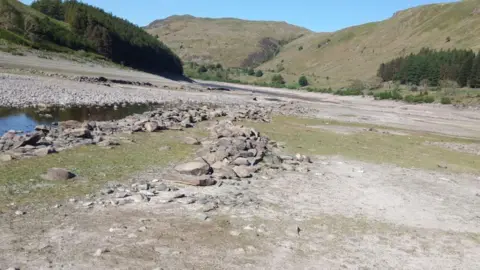Flooded village re-emerges in dry spell
 Mike Crees
Mike CreesA village which was deliberately flooded to make a reservoir has re-emerged due to lack of rain fall.
Mardale village in the Lake District disappeared when the Haweswater valley was flooded in 1939 to create the structure to provide water for the north-west of England.
The Environment Agency said the reservoir, which has capacity for about 85,000 million litres (18,697 million gallons) of water, was 30% lower than it should be at this time of year.
Visitor Mike Cree, of Kendal, said the area was "hot and dry as a bone" and the reservoir water levels looked between 12 to 15ft (4.5m) lower than usual.
The Environment Agency warned there was a risk of droughts in some areas as the dry spell continued.
"This May has seen a continuation of the dry weather and low rainfall across England," a spokeswoman said.
"With little rainfall during the first part of the month, this continues to impact on public water supply reservoirs in central and northern England."
She also said it was the driest spell England had had at this time of year since 1956.
She added: "Haweswater reservoir crossed drought level one on 1 May and the regional reservoir storage continues to decrease.
"On average, storage is 30% below expected level."
 Mike Cree
Mike CreeThe Haweswater Dam was considered to be an engineering feat at the time.
Construction started in 1929, but was abandoned for three years between 1931 and 1934.
Once completed, it took almost a year to fill with the first recorded water overtopping and flowing down the overflow slipway in 1941.
Crowds gathered for the last service to be held at Mardale church.
Before it was flooded, villagers were moved out and their homes and other buildings dismantled.
Bodies buried in the village's church graveyard were exhumed and many reburied at Shap.
Windows and some of the stones from the church were reused in the draw-off tower situated a little way back from the dam wall.
About 200 men worked on the construction of the dam and lived in a temporary village called Burnbanks.
